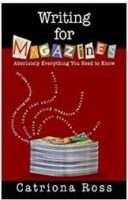Right. You’ve come up with a list of good story ideas. Now you need to select suitable magazines for your articles and successfully pitch them to their features editors. Your order of work as a freelance writer should usually be…
1. Find idea.
2. Query magazine.
3. Get commissioned.
4. Research story.
5. Write up story.
6. Submit story to magazine by deadline.
In general, don’t write the story until you have a buyer (called ‘writing on spec’). The expression comes from the word ‘speculate’ – you’re hoping to gain financially, but risking loss. Sometimes, however, features editors will invite you, a new journalist, to write your proposed piece on spec – meaning they’re entitled to turn it down without paying you if they don’t want it – and sometimes it’s worth your while to do this. When you’re breaking in to writing, you need to act strategically and do what it takes to get your first article published. This could mean writing on spec for a while, or accepting assignments that don’t pay brilliantly just to get your name out there.
***
Okay, let’s get started
First, I’d suggest you collect a pile of publications you’d like to write for, and read them cover to cover. Then match your story idea to a few magazines. For each idea, jot down three magazines to which you feel your article is well suited.
When seeking magazines to query, don’t restrict yourself to the big, mainstream names. There’s a lot of competition to write for these titles, and, as a newcomer, you may have a better chance of selling to smaller, regional titles, trade journals and special interest magazines. These publications may be less sexy than the thick glossies, but you could get your foot in the door more easily. Consider the following:
Store club card magazines
Trade publications for specific industries and professions, such as the travel industry, engineering, law, architecture, medical and veterinary
Lifestyle/health/fitness magazines published by insurance companies
Government publications
Minority magazines: small publications that cater for particular ethnic or religious groups
University/college alumni magazines
Your local theatre magazine
Corporate in-house magazines
Find the right person to approach. Study the magazine’s masthead – the list of names and job titles, usually found in the first pages of a magazine. The person to approach is the features editor (sometimes called commissioning editor or features director), usually listed in the section marked ‘Editorial’ or ‘Features’. If the publication has no features/commissioning editor, send your query directly to the editor. Get his or her name and email address – if necessary, phone the magazine and ask the receptionist for the email address. Magazine staffers change jobs frequently, so always make sure you have the name of the current editor or features editor.
Send an inviting, well-written query. This handy vehicle serves as an emailed letter of introduction and story pitch in one. Basically, you’re asking whether an editor would be interested in buying and publishing your story. When querying, aim to sell your story idea, showing why it’s perfect for the magazine in question and why you’re the right person to write it. You get one chance to hook an editor, so there’s nothing wrong with devoting an hour to composing a great query. The perfect query is brief (no longer than a page), positive, snappy and gripping. Make sure your brief is as well written as the story you intend writing, and showcases you in a flattering light (just don’t overdo the self-promotion).
Should you query by email, by phone or in person? Though querying by email isn’t the only way, I think it’s the best way. Editors are stupendously busy, so a meeting or a phone call is likely to elicit the response, ‘Why don’t you put that in writing and email it to me?’
Example of query email:
This is an actual sample of a successful query I submitted recently. The emails secured me a commission, the article I wrote was published, and I was paid. Mission accomplished.
Sent to the editor of the lifestyle magazine supplement for a national Sunday newspaper.
Email subject: The New Branding: Just click ‘Send’?
Dear Laurice,
Would you be interested in a piece on a growing techno-trend? I’ve noticed that many of the emails I now receive end with a personal ‘pay-off line’. Some of these maxims are witty (‘Most men occasionally stumble over the truth, but most pick themselves up and continue as if nothing happened’ – Winston Churchill, used by a freelance writer), some profound (‘To be ignorant of one’s ignorance is the malady of the ignorant’, used by the editor of Sunday World), some instructive (‘If you have the choice between being right or kind, choose kind…’, used by a local composer and conductor.)
What does this say about the people who use these personalised signatures? Are they wiser than the rest of us to the power of branding, and are they cunningly applying it to themselves as individuals? If you want to promote yourself as a certain type, what sort of line should you choose? (I’ve noticed, for example, that quotes by Einstein are popular – genius by association?) I’d like to ask a corporate image coach and a psychologist for comment. Which industries discourage such flagrant displays of individuality? Which allow these signatures to flourish? Is this (bear with me) the new epitaph – the way you’d like to be remembered by the world once you’re gone? If so, choose wisely…
About myself: A freelance journalist, I’m a past features writer on Style and Cosmopolitan, and former features editor on Cosmo and, most recently, O, The Oprah Magazine. My first novel, The Love Book, was published in 2005 by Oshun.
Let me know if you’re interested.
Best wishes,
Catriona

